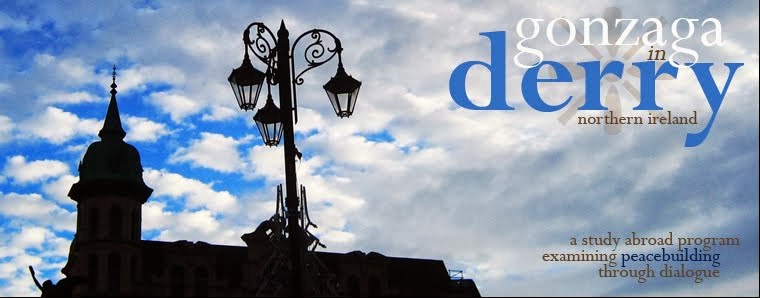
By Ron Bateman
A small 2 x 2 poster caught my eye as I was leaving the Museum of Free Derry. After two hours visiting with the Museum’s Outreach & Education Coordinator, John Kelly, I nearly missed the simple, elegant little poster next to the door. A broken circle set on a stained red background. An empty shell casing centered above the words “Truth, Justice, Healing”. The poster instantly brought John’s story into focus.
| John Kelly |
Without pause, in a voice that has spoken the story countless times in the past four decades, John begins: “The thing about Michael is he was never at a march before. I spoke to him just before the march and just warned him to be careful and if anything happened to just go home. He just never got the opportunity. He was standing outside…behind a barricade on Rossville Street. In a crowd of about 30-40 people when a soldier fired a shot into the crowd and Michael was the unlucky one. Could have been any one of the 30-40 people.”
The randomness doesn’t seem to bother John; the senselessness does. If the bullet hadn’t found Michael, it would’ve found another. He was only yards away, crouching behind cover when he saw his brother, shot in the stomach, being brought out of a flat in Abbey Park. He rode with his brother in the ambulance to the hospital. The doctor pronounced Michael dead upon arrival. When his father arrived just before six p.m., he relayed the terrible news. “I still remember him sliding down the wall, crying.”
John’s work with the Bloody Sunday Trust began as a Family Liaison Officer in 1997. He acted as a conduit for the families and the outside world as they pushed to get the truth out about the events of that day and the subsequent cover-up. In 2004, he moved into the position he now holds at the museum.
John’s voice swells with pride when he speaks of the day in June 2010 when the Saville Report was released and his brother and the others killed that day were exonerated. Gathered with other family members inside Guild Hall, waiting for nearly 5 hours for British Prime Minister David Cameron’s statement, they could barely contain themselves. “It’s been a long journey. It took us 38 ½ years to get the full declaration of innocence for our people. During the campaign we had three demands: one was the declaration of innocence for our people, the second was the repudiation of Widgery…and the third one was the prosecution of the soldiers.”
| Pointing to a picture of his brother, Michael |
| Michael was shot near the lamp post centered in picture |
John’s is a story that isn’t finished, though. Like that broken circle on the poster, he and the family members that remain (and remember) feel that justice has yet to be seen. His work in the Museum of Free Derry and the Saville Report have provided both truth and healing, but justice remains elusive. He believes that, “the healing process for me is a constant process whereby I am able to talk about it every day and relay the story of what happened through my work. I think it boils down to the satisfaction of knowing that when people come in here they walk away with the true story.”
| John pointing to Michael's picture |
Before leaving John took time to show me something I hadn’t seen in the poster – the blurry faces of the 14 civilians killed that afternoon. Hidden in the gold band, broken and interrupted by the shell casing, is each lost life. He reminded me that, "This was never about vengeance. This was about truth and justice, about the fact that 14 innocent people were murdered and the British Government covered it up. Over the years we were castigated; we were ignored."
John’s journey for justice continues.


No comments:
Post a Comment